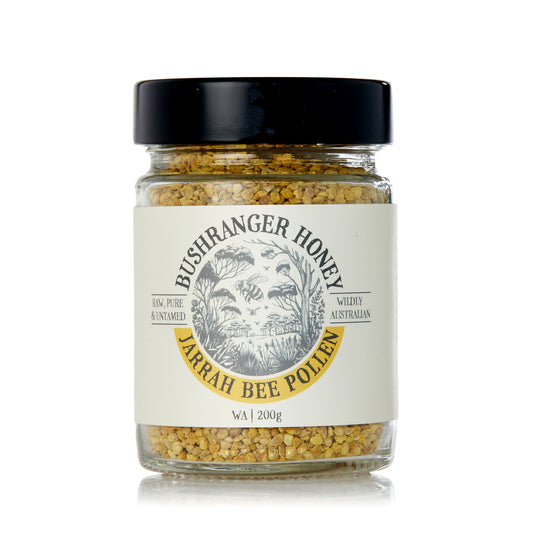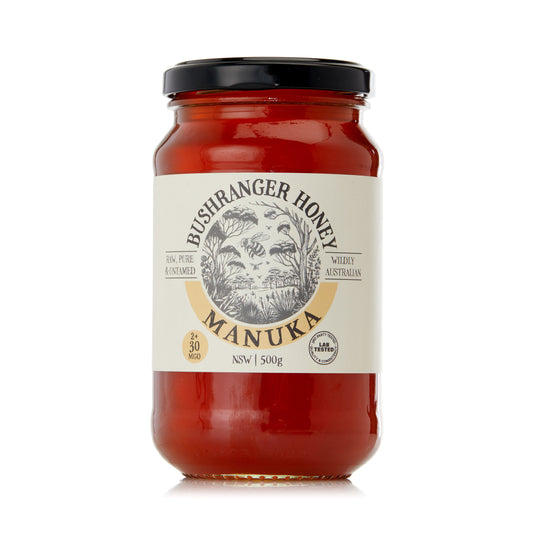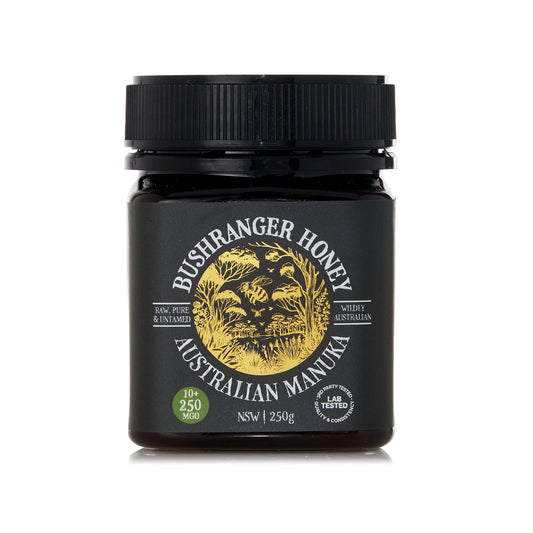CHRISTMAS SPECIALS
Stock up on premium Australian Manuka honey with these unbeatable bundle deals. Each bundle includes bonus products and massive savings, only while stocks last.
-
Buy 2 Get 1 Free 250MGO Manuka
Regular price $83.90 AUDRegular priceUnit price / per$125.85 AUDSale price $83.90 AUDSale -
BUY 3 GET 2 FREE - 10+ Manuka Honey 250 MGO
Regular price $125.85 AUDRegular priceUnit price / per$209.75 AUDSale price $125.85 AUDSale -
BUY 3 GET THE 4th FREE - 1400 MGO Manuka Honey
Regular price $419.85 AUDRegular priceUnit price / per$559.80 AUDSale price $419.85 AUDSale
Bushranger Honey Top Picks
Handpicked favorites from our range of premium Australian Manuka honey and other products. These customer-loved selections showcase the pure, powerful taste of the Bushranger collection.
-
Bushranger Jarrah Bee Pollen Western Australian
Regular price From $50.00 AUDRegular priceUnit price / per -
Bushranger Honey 2+ 30 MGO Australian Manuka
Regular price From $18.95 AUDRegular priceUnit price / per -
Bushranger Honey 10+ Manuka Honey - 250 MGO
Regular price From $26.95 AUDRegular priceUnit price / per

All About Bushranger Honey
Bushranger Honey is a family-owned business from New South Wales, dedicated to providing premium, pure, raw honey. Our beekeepers have generational expertise in honey cultivation, deeply connected to the local landscape and native flora. Our Manuka honey, rich in methylglyoxal (MGO), is tested and certified for authenticity, known for its potent natural healing properties.
All Bushranger Honey is cold-extracted, wild-crafted, and lightly filtered to stay raw, pure, and untamed — just like the land it comes from. Wildly Australian.
FAQs
What Exactly is Manuka Honey?
- Manuka honey is a type of monofloral honey
produced by bees that forage on the Leptospermum plant, native to
Australia and New Zealand. It contains high levels of Methylglyoxal (MGO),
a naturally occurring compound responsible for its unique antibacterial,
anti-inflammatory, and antimicrobial properties.
- Australia has over 80 species of Leptospermum,
many of which produce honey with high MGO content; in some cases, equal to or
exceeding that of New Zealand Manuka.
What is MGO and how is it measured?
MGO stands for Methylglyoxal — the powerful, naturally occurring compound that gives Manuka honey its antibacterial strength. Unlike regular honey, which relies on hydrogen peroxide for its activity, MGO remains stable and effective, even inside the body or when exposed to heat.
The MGO rating tells you how much Methylglyoxal is present in the honey, measured in milligrams per kilogram (mg/kg). The higher the number, the more potent the honey’s healing power.
- 100MGO: Gentle and nourishing — perfect for daily wellness, immune support, and general use.
- 250MGO: A step up in strength — helps with sore throats, mild digestive issues, and seasonal colds.
- 500MGO: High potency — great for skin care, wound support, and stronger immune needs.
- 750MGO Pure, wild strength — used for advanced healing, infections, and serious wellness rituals.
Each batch of authentic Manuka honey is independently tested to verify its MGO content — so what you see on the label is exactly what nature put in the jar.
What makes Manuka honey special compared to regular honey?
- While all raw honey has natural antibacterial properties due
to its hydrogen peroxide content, Manuka honey has a non-peroxide activity
(NPA) that persists even when peroxide is broken down — thanks to MGO.
This means:
- It remains effective in the body (e.g., digestive tract)
- It can be applied topically to wounds, burns, or skin infections
- It’s more stable under heat and light
What are the scientifically supported benefits of Manuka honey?
Internally:
- Boosts immune system function
- Helps reduce sore throats and coughs
- Soothes acid reflux and gastric ulcers
- Supports gut flora and digestion
Externally:
- Promotes wound healing (even chronic wounds)
- Fights bacterial skin infections like staph and acne
- Helps with burn recovery
- Can be used on eczema-prone skin
Multiple clinical studies confirm its effectiveness against MRSA,
Staphylococcus aureus, and other antibiotic-resistant bacteria.
Is Australian Manuka honey as good as New Zealand Manuka honey?
Yes — and in some cases, scientifically superior.
- Australia’s diverse Leptospermum species allow for year-round flowering,
producing a broader harvest window. - Australian Manuka honey has been found to match or exceed NZ Manuka in MGO potency.
- Testing standards are similar, although
New Zealand also uses the UMF® grading system (Unique Manuka Factor),
while Australia generally focuses on MGO and NPA.
Why does Manuka honey cost more than regular honey?
- Key reasons include Limited geographic availability of Leptospermum nectar
- Strict harvesting and testing protocols
- High therapeutic value, making it both a food and a natural medicine
- Small batch, artisan production methods
- The higher the MGO content, the higher the price,
due to its rarity and potency.
Do you ship honey internationally?
Currently, we do ship internationally! Due to customs regulations regarding food products, shipping honey across borders can be limited. Please check the available regions at the bottom of our page.
Please note: Not available in Western Australia.









